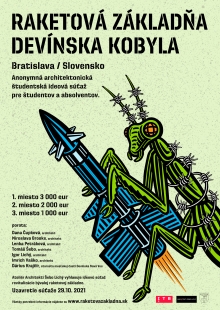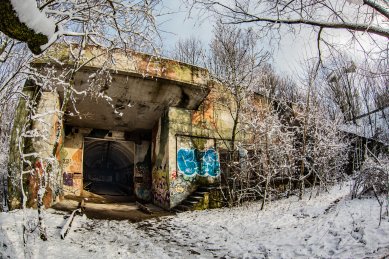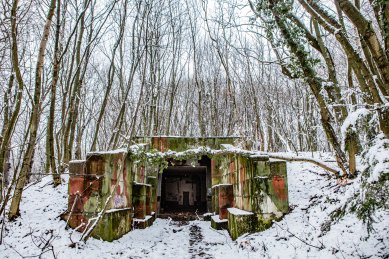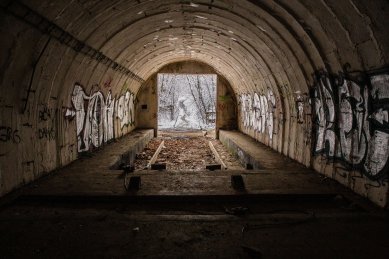
Rocket Base Devínska Kobyla - Student Ideational Competition
Source
Andrea Bystrická
Andrea Bystrická
Publisher
Tisková zpráva
01.06.2021 10:15
Tisková zpráva
01.06.2021 10:15
Slovakia
Bratislava
Architekti Šebo Lichý s. r. o.
What will be the future of Devínska Kobyla?
Devínska Kobyla is a mountain massif on the southwestern edge of Bratislava. It is a natural landmark at the confluence of the Morava and Danube rivers. From its summit, there is a view of the city, into Austria and Hungary, and, in good visibility, even to the Czech Republic. It is part of the Protected Landscape Area of the Little Carpathians, belongs to the network of protected areas of the EU member states NATURA 2000, and is an extremely popular excursion destination for (not only) residents of Bratislava.
A remarkable place with a rich history
Devínska Kobyla is a remarkable place for many reasons. Its geographical location at the southernmost protrusion of the Little Carpathians makes it a strategic natural and geopolitical interface. On one hand, the habitats of two distinct regions - the Pannonian and the Western Carpathian - converge here; on the other hand, it has repeatedly been the boundary of different political entities in the past. While in the first case, the convergence has resulted in remarkable biodiversity and extraordinary botanical, zoological, geological, and paleontological values, in the second case, it has left a material heritage in the form of a diverse range of military defensive structures. The Devín Castle, as a historically and touristically significant monument, needs no mention. However, the summit of Devínska Kobyla also hides another military structure – from the times of the Iron Curtain. In the 1980s, the socialist army built a rocket base here as part of the defense of the Warsaw Pact states against NATO's air force and missiles. The socialist regime was plagued by the conviction of hostile intentions from the "imperialist" west, and despite ongoing peace, it had a constant need to demonstrate its military might. For these purposes, "peaceful" firing positions were built in exposed locations.
The army operated the rocket base until almost the turn of the millennium. When it finally left in 1997, nature took over command. Today, the entire area is a freely accessible recreational area. During a walk, we can find only dilapidated concrete remnants of military buildings, seemingly randomly scattered among the greenery. Nature slowly usurps them and covers them with a veil of vegetation, just as time steals and shrouds our memories of the dark period associated with them in a veil of forgetfulness. The existence of the Iron Curtain is connected with numerous tragic stories of people who risked their lives in the desire for freedom. To this day, this dark chapter of history does not have sufficient museum representation in Slovakia that would keep the fading memories alive for future generations. The robust construction structures in the protected natural area represent a significant ecological burden, but they also have unique potential and provide us with a rare opportunity to work with the past and the future simultaneously.
An opportunity for young architects
The initiative should be supported by an upcoming student ideation competition organized by the authors of the new observation tower, architects from the Šebo Lichý studio. It will take place from June 1 to October 29, 2021, and students will be tasked with proposing a program for the use of the area. They will have to seek answers to several complex questions. How to activate and at the same time protect the area? How to present historical and ecological themes in a combination of physical artifacts and virtual experiences? How to synchronize the accessibility and remoteness of the place with its new functions? What tools to support the preservation of the area and its recent military-political archaeology? How to reconcile the antagonistic interests of nature, memorials, research campuses, and tourism? The resulting proposals should serve as a catalog of inspirations for property owners in seeking a program and method for their use, as well as inspiration for the city district for potential investments in infrastructure, and finally for the city council when defining new regulations.
All information about the competition can be found on the website www.raketovazakladna.sk
Devínska Kobyla is a mountain massif on the southwestern edge of Bratislava. It is a natural landmark at the confluence of the Morava and Danube rivers. From its summit, there is a view of the city, into Austria and Hungary, and, in good visibility, even to the Czech Republic. It is part of the Protected Landscape Area of the Little Carpathians, belongs to the network of protected areas of the EU member states NATURA 2000, and is an extremely popular excursion destination for (not only) residents of Bratislava.
A remarkable place with a rich history
Devínska Kobyla is a remarkable place for many reasons. Its geographical location at the southernmost protrusion of the Little Carpathians makes it a strategic natural and geopolitical interface. On one hand, the habitats of two distinct regions - the Pannonian and the Western Carpathian - converge here; on the other hand, it has repeatedly been the boundary of different political entities in the past. While in the first case, the convergence has resulted in remarkable biodiversity and extraordinary botanical, zoological, geological, and paleontological values, in the second case, it has left a material heritage in the form of a diverse range of military defensive structures. The Devín Castle, as a historically and touristically significant monument, needs no mention. However, the summit of Devínska Kobyla also hides another military structure – from the times of the Iron Curtain. In the 1980s, the socialist army built a rocket base here as part of the defense of the Warsaw Pact states against NATO's air force and missiles. The socialist regime was plagued by the conviction of hostile intentions from the "imperialist" west, and despite ongoing peace, it had a constant need to demonstrate its military might. For these purposes, "peaceful" firing positions were built in exposed locations.
The army operated the rocket base until almost the turn of the millennium. When it finally left in 1997, nature took over command. Today, the entire area is a freely accessible recreational area. During a walk, we can find only dilapidated concrete remnants of military buildings, seemingly randomly scattered among the greenery. Nature slowly usurps them and covers them with a veil of vegetation, just as time steals and shrouds our memories of the dark period associated with them in a veil of forgetfulness. The existence of the Iron Curtain is connected with numerous tragic stories of people who risked their lives in the desire for freedom. To this day, this dark chapter of history does not have sufficient museum representation in Slovakia that would keep the fading memories alive for future generations. The robust construction structures in the protected natural area represent a significant ecological burden, but they also have unique potential and provide us with a rare opportunity to work with the past and the future simultaneously.
An opportunity for young architects
The initiative should be supported by an upcoming student ideation competition organized by the authors of the new observation tower, architects from the Šebo Lichý studio. It will take place from June 1 to October 29, 2021, and students will be tasked with proposing a program for the use of the area. They will have to seek answers to several complex questions. How to activate and at the same time protect the area? How to present historical and ecological themes in a combination of physical artifacts and virtual experiences? How to synchronize the accessibility and remoteness of the place with its new functions? What tools to support the preservation of the area and its recent military-political archaeology? How to reconcile the antagonistic interests of nature, memorials, research campuses, and tourism? The resulting proposals should serve as a catalog of inspirations for property owners in seeking a program and method for their use, as well as inspiration for the city district for potential investments in infrastructure, and finally for the city council when defining new regulations.
All information about the competition can be found on the website www.raketovazakladna.sk
The English translation is powered by AI tool. Switch to Czech to view the original text source.





0 comments
add comment






